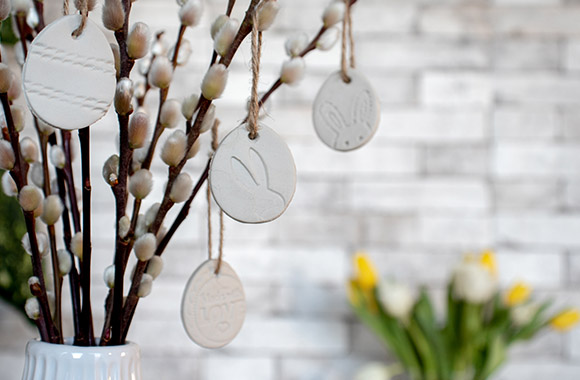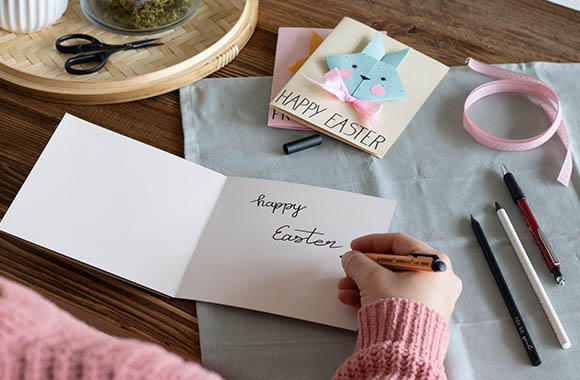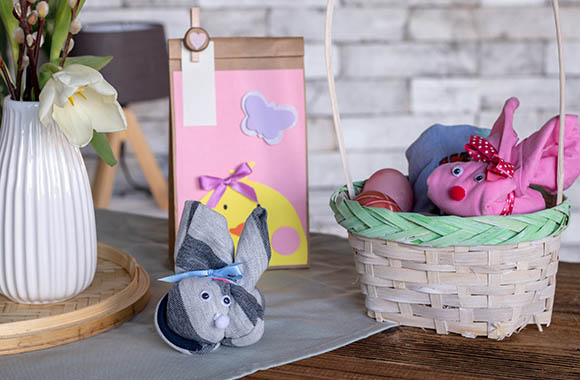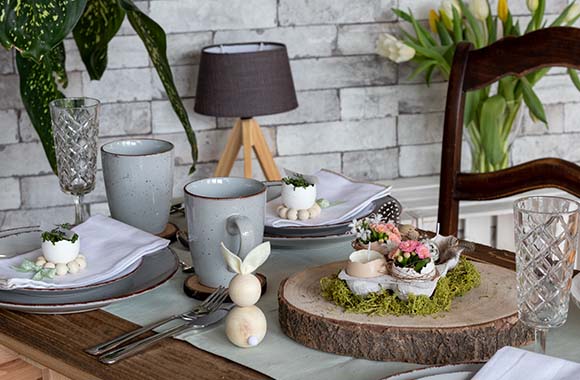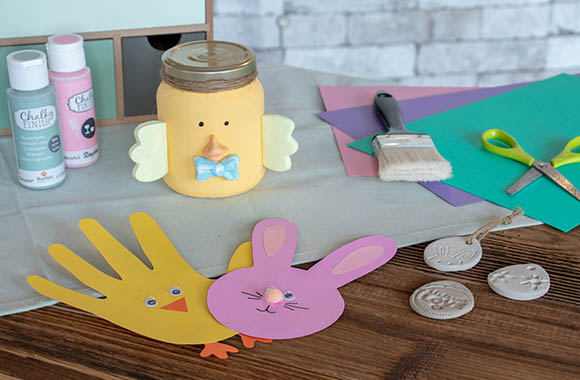Dyeing Easter eggs naturally
Designing, painting, and then hunting for eggs is an integral part of classic easter traditions. Natural Easter egg colours are safe and environmentally sustainable. We show you how to dye eggs naturally and which foods are best suited for Easter egg painting. We also give you some ideas on how to creatively design Easter eggs.
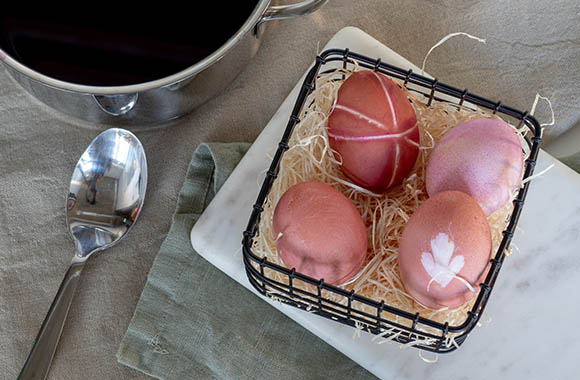
Contents:
Dyeing eggs using natural dyes
Many foods have natural dyes that you can use to create wonderfully colourful Easter eggs. Colours such as yellow, orange, green, red, blue and violet can be made from food without much effort.
Here is an overview of which egg colour can be made from which food:
| Yellow | Turmeric (fresh or powder) |
| Orange | Oranges, Onion skins, carrots |
| Green | Spinach, nettle, parsley, maté tea | Red | Beetroot, hibiscus tea |
| Blue | Hibiscus flower tea, fresh red cabbage, blueberries |
| Violet | Elderberry juice, red onion skins |
Use either white or brown egg depending on what colour you want the Easter egg to be in the end. White eggs work very well with light colours like yellow or green and also work with dark colours. Brown eggs, on the other hand, only work well with darker colours.
It is best to use an old enamel pot and old bowls for dyeing eggs. Some dyes stain easily and are hard to remove.
It is best to use an old enamel pot and old bowls for dyeing eggs. Some dyes stain easily and are hard to remove.
Instructions: Using foods to dye eggs
- Start by hard boiling your eggs. To make them last longer, we recommend cooking them for at least 10 minutes.
- Drizzle some vinegar on a kitchen towel and rub the eggs into it. This helps to rub off the expiry date printed on the eggs and also roughens the shell so that the natural dyes stick better.
-
The next step is to make the colouring broth. To make sure there is enough dye in the mix, use the following ratios for every half-litre of water:
- Vegetables: 500 g
- Powder/spices/tea: 3 tablespoons
- Juice: ½ litre
- Peels: 2 handfuls
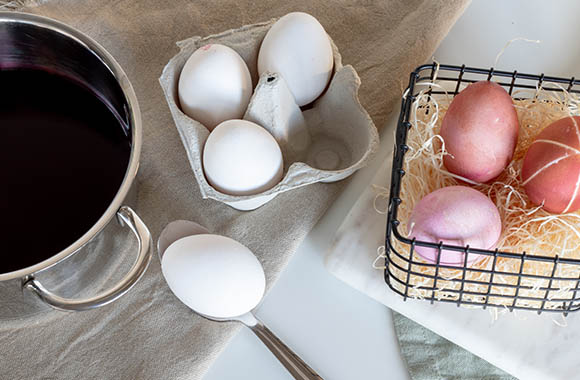
- Boil the ingredients for about 30 minutes to dissolve the dyes. After that, pour the dye mix through a sieve and let it cool.
- Now place the vinegar-treated eggs into the dye so that they are completely covered. For pastel colours, leave the eggs to infuse for about 2 to 10 minutes, depending on the intensity of the dyes. For really intense colours, let them soak in the natural dye for 30 minutes up to several hours.
- When you are happy with the colour, take your Easter eggs out of the dye and leave them to dry on a kitchen towel.
To make your home-dyed Easter eggs shine nicely, rub them with a little cooking oil after drying.
To make your home-dyed Easter eggs shine nicely, rub them with a little cooking oil after drying.
More alternatives to dying Easter eggs naturally
If you are too busy and don’t have the time to make a dye yourself, there are a few alternatives. Organic egg dye, for example, is made from sustainable ingredients and is completely safe. You can find organic Easter egg colours in organic markets, health food shops, pharmacies, or online.
Alternatively, you can use organic food colouring as a dye. First, boil the eggs for 10 minutes. Then bring ½ litre of water to the boil and add 4 teaspoons of vinegar and 4 teaspoons of organic food colouring. Then carefully place the eggs in the water and leave them to soak until you are happy with the colour.
DIY designing & egg painting ideas
Do you want to get creative and make some beautifully coloured eggs? Here are some ideas on making and designing Easter eggs. You can add some variety to your homemade Easter nest and try out some new design ideas.
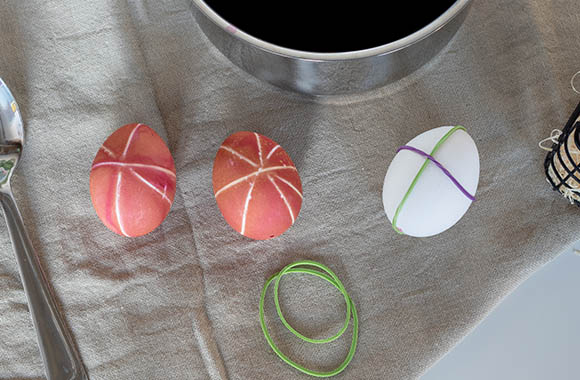
Designing Easter eggs – marbling effect
Try adding the dyeing ingredients to the pot without stirring, this will give a wild and unique ‘marble’ pattern. As the ingredients cover the eggs, the different colours will touch the egg and leave a pretty marbled pattern.
Painting Easter eggs – lines and geometric shapes
If you prefer a bit more texture, you can use rubber bands, washi tape, or hot glue. Try wrapping rubber bands around the egg before it is coloured. This creates fine lines that add contrast to the finished egg. Or use a hot glue gun to paint lines or even patterns on the uncoloured egg that will stay as uncoloured lines. You can even mask geometric shapes with washi tape before colouring the egg.
Modern Easter eggs – Natural patterns
Natural patterns go particularly well with naturally coloured Easter eggs. Delicate flowers, herbs, and thin leaves make perfect stencils. Place a flower, herb, or leaf on the side of an un-dyed egg and then secure it by wrapping and knotting an old pair of nylon tights. Then dye the egg in the same way as before. When it’s dry, remove the tights and ‘stencil’ and you are left with a beautiful egg with a natural imprint.
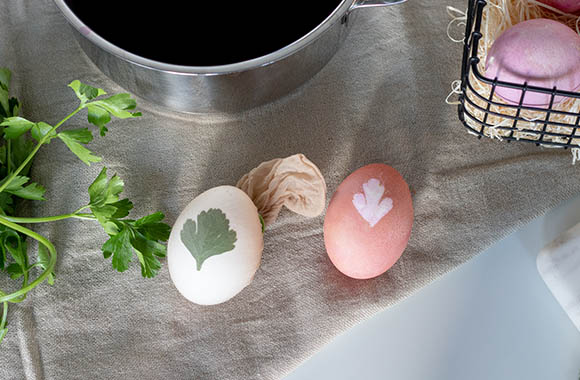
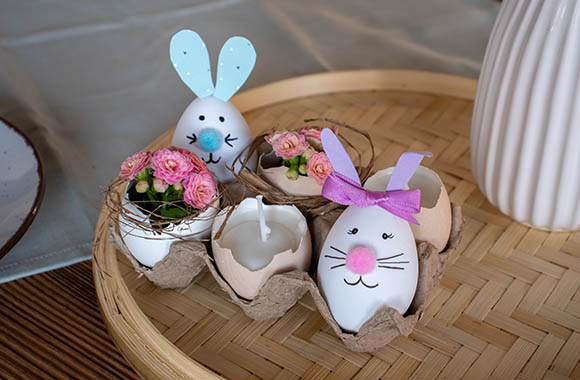
Easter egg craft - Cute Easter egg figures
If you want to make Easter crafts with your child, then these cute Easter egg figures are just the thing for you. With some cardboard and glue, you can create fun figures with either plain or dyed eggs. You can be as creative as you like when designing, gluing, or painting your Easter eggs.
Vinegar can be used to wash off the natural colours. You can use this to create an effect. Use vinegar on a cotton bud to dab dots on an egg that has already been coloured.
Vinegar can be used to wash off the natural colours. You can use this to create an effect. Use vinegar on a cotton bud to dab dots on an egg that has already been coloured.

